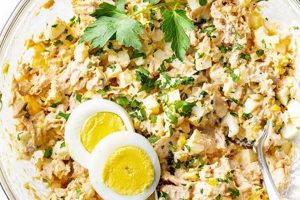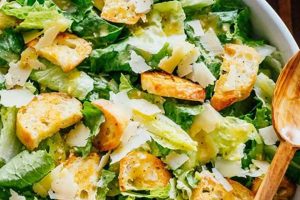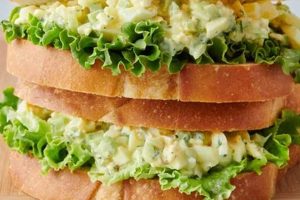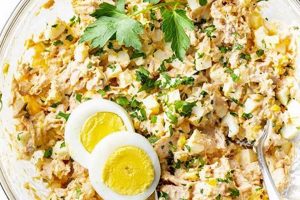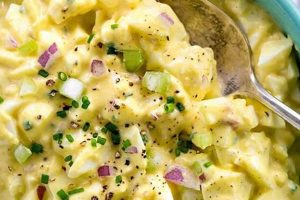A classic dish featuring cooked elbow macaroni, mayonnaise, and hard-boiled eggs, this salad often incorporates additional ingredients like celery, onion, mustard, relish, and seasonings. Variations can include different types of pasta, vegetables, proteins, and dressings, allowing for a wide range of flavor profiles. A simple version might combine cooked macaroni, mayonnaise, chopped celery, diced hard-boiled eggs, onion, salt, and pepper.
This dish offers a balance of carbohydrates, protein, and fats, making it a satisfying side or main course option. Its adaptability to diverse palates and dietary needs contributes to its enduring popularity. Historically, macaroni salads gained prominence in the early 20th century, coinciding with the rise of convenient, pre-made food products. The simplicity of preparation and the ability to customize the ingredients make it a versatile choice for picnics, potlucks, and everyday meals. The inclusion of eggs adds a richness and nutritional value appreciated by many.
This exploration will further delve into specific variations, ingredient selection, preparation methods, and tips for creating a perfect rendition of this culinary staple.
Tips for Creating Exceptional Macaroni Salad with Eggs
Achieving optimal flavor and texture in macaroni salad involves attention to detail throughout the preparation process. These tips offer guidance for creating a superior version of this classic dish.
Tip 1: Pasta Perfection: Cook macaroni al dente for optimal texture. Overcooked pasta becomes mushy in the salad. Rinse cooked pasta under cold water to stop the cooking process and maintain firmness.
Tip 2: Egg-cellent Execution: Perfectly cooked hard-boiled eggs are essential. Overcooked yolks can become dry and crumbly. Aim for a firm, yet creamy yolk. An ice bath immediately after boiling helps with peeling and prevents a greenish ring around the yolk.
Tip 3: Ingredient Incorporation: Chop vegetables into consistent sizes for even distribution of flavor and appealing aesthetics. Smaller pieces blend seamlessly, while larger pieces provide textural contrast.
Tip 4: Dressing Dynamics: Thoroughly combine dressing ingredients separately before adding them to the pasta and other components. This ensures even flavor distribution. Add dressing gradually, adjusting the amount to achieve the desired consistency.
Tip 5: Seasoning Savvy: Seasoning should be layered throughout the process. Salt the pasta water generously during cooking. Add additional seasonings to the dressing and adjust to taste after combining all ingredients.
Tip 6: Chilling is Key: Refrigerate the salad for at least one hour before serving to allow the flavors to meld. Chilling also enhances the salad’s refreshing quality.
Following these tips ensures a macaroni salad that is not only flavorful but also visually appealing and texturally satisfying. Attention to these details elevates this simple dish to a culinary masterpiece.
By implementing these techniques, one can create a macaroni salad with eggs that stands out in terms of both flavor and presentation. The following section will conclude this exploration with a summary of key takeaways.
1. Ingredient Quality
Ingredient quality significantly impacts the final flavor and overall enjoyment of macaroni salad with eggs. Selecting superior components elevates this seemingly simple dish, transforming it from ordinary to exceptional. The following facets illustrate the crucial role ingredient quality plays in this classic recipe.
- Freshness of Produce:
Crisp, fresh vegetables contribute significantly to the salad’s texture and flavor. Wilted or aged produce can impart off-flavors and detract from the overall quality. For instance, using crisp celery and a pungent onion adds brightness and complexity compared to using limp, older vegetables. The difference is readily apparent in the final product.
- Mayonnaise Matters:
Mayonnaise serves as the foundation of the dressing, influencing both flavor and texture. High-quality mayonnaise, often made with real eggs and minimal additives, provides a rich, creamy base. Conversely, lower-quality mayonnaise can be overly tangy or have an artificial taste, negatively impacting the salad’s overall flavor profile. Opting for a premium mayonnaise noticeably elevates the dish.
- Egg Excellence:
Farm-fresh eggs generally possess richer yolks and a superior flavor compared to older eggs. This richness enhances the salad, contributing to its overall depth of flavor and creamy texture. The difference in taste between fresh, high-quality eggs and older, less flavorful eggs is particularly noticeable in a simple dish like macaroni salad.
- Pasta Particulars:
While often overlooked, the type of pasta used impacts the salad’s texture. High-quality pasta holds its shape better after cooking and absorbs the dressing more effectively. This results in a more appealing texture and a more even distribution of flavor. Using a superior pasta variety prevents a mushy texture and ensures each bite is flavorful.
The cumulative effect of using high-quality ingredients in a macaroni salad with eggs is undeniable. Each component contributes to the final flavor profile and overall enjoyment. Prioritizing ingredient quality ensures a superior culinary experience, transforming this classic dish into a truly satisfying meal.
2. Precise Cooking
Precise cooking techniques are essential for achieving optimal texture and flavor in macaroni salad with eggs. Overcooked or undercooked components can negatively impact the final dish, resulting in a less satisfying culinary experience. Careful attention to cooking times and methods ensures a harmonious blend of textures and flavors.
- Pasta Texture:
Cooking pasta al dente is crucial for maintaining its structural integrity within the salad. Overcooked pasta becomes mushy and absorbs too much dressing, leading to a heavy, less appealing texture. Conversely, undercooked pasta remains firm and unpleasantly chewy. The ideal texture is firm to the bite yet tender, achieved by following the package directions and testing for doneness frequently. This ensures the pasta retains its shape and provides a pleasant textural contrast to the other ingredients.
- Egg Yolk Consistency:
Precisely cooked hard-boiled eggs are essential for a creamy, flavorful salad. Overcooked yolks become dry, crumbly, and develop an unpleasant grayish-green ring. Undercooked yolks, on the other hand, are runny and unappetizing. The perfect hard-boiled egg has a firm, yet creamy yolk, achieved by carefully timing the boiling process and immediately immersing the eggs in an ice bath to stop the cooking. This method yields yolks with a vibrant yellow color and a smooth, creamy texture that complements the other ingredients.
- Vegetable Tenderness:
If incorporating vegetables like celery or onions, their cooking, if any, needs careful attention. Overcooked vegetables become mushy and lose their flavor, while undercooked vegetables can be too firm and create an unpleasant raw taste. Blanching or lightly steaming vegetables can enhance their color and tenderness while preserving their crispness. This technique allows vegetables to retain their distinct flavors and textures, adding complexity to the salad.
- Even Cooling:
Rapid and even cooling of both the pasta and eggs is essential to prevent further cooking and maintain optimal texture. Rinsing the cooked pasta under cold water halts the cooking process and firms the pasta. Similarly, plunging hard-boiled eggs into an ice bath after cooking stops the residual heat from overcooking the yolks. This ensures the ingredients remain at their ideal texture and temperature, ready to absorb the dressing and other flavors.
Precise cooking methods are fundamental to a successful macaroni salad with eggs. Properly cooked ingredients contribute to a harmonious blend of textures and flavors, elevating the dish from simple to exceptional. Attention to detail in each step, from boiling the pasta to preparing the eggs and vegetables, results in a salad that is both visually appealing and satisfying to the palate.
3. Flavor Balance
Flavor balance is paramount in a successful macaroni salad with eggs. A harmonious interplay of tastes elevates this simple dish, creating a complex and satisfying culinary experience. Disproportionate flavors can result in a bland or overpowering salad, highlighting the importance of careful consideration of each ingredient’s contribution to the overall taste profile.
- Creaminess vs. Acidity:
The creamy richness of mayonnaise provides a foundational element, balanced by the tangy acidity of ingredients like vinegar, mustard, or relish. This interplay prevents the salad from becoming overly rich or excessively sharp. For example, a dill pickle relish contributes both acidity and a refreshing crunch, complementing the creamy dressing. The balance of these elements creates a more dynamic flavor profile.
- Saltiness vs. Sweetness:
A subtle touch of sweetness can enhance the overall flavor complexity, counteracting the saltiness from ingredients like mayonnaise, mustard, and seasonings. A small amount of sugar or a sweeter onion variety can achieve this balance. A touch of sweetness rounds out the flavor profile, preventing an overly salty or one-dimensional taste. This subtle interplay adds depth and complexity.
- Savory Notes:
Incorporating savory elements like celery, onion, or fresh herbs adds depth and complexity. These ingredients provide a counterpoint to the creamy and tangy components, preventing the salad from becoming overly sweet or cloying. Fresh dill, for example, imparts a bright, herbaceous note that complements the other flavors. The inclusion of savory notes enhances the overall balance and appeal.
- Spice and Heat (Optional):
A touch of spice, such as a pinch of cayenne pepper or a dash of hot sauce, can add a pleasant kick and further complexity. However, it’s crucial to use spice judiciously to avoid overpowering the other flavors. A small amount of paprika, for example, can contribute a subtle smokiness and warmth without overwhelming the palate. This judicious use of spice enhances the overall flavor profile without dominating the other ingredients.
Achieving flavor balance in macaroni salad with eggs is an art of proportion and thoughtful ingredient selection. A well-balanced salad offers a complex interplay of creamy, tangy, savory, and potentially spicy notes, resulting in a dish that is far more satisfying than the sum of its parts. The careful consideration of each flavor component contributes to a harmonious and delightful culinary experience.
4. Textural Contrast
Textural contrast significantly contributes to the enjoyment of macaroni salad with eggs. A variety of textures creates a more dynamic and engaging sensory experience. The interplay of different textures adds complexity and prevents the salad from becoming monotonous. This contrast arises from the careful combination of ingredients and their preparation.
The firm, yet tender, pasta provides a foundation. Its tubular shape offers a slight resistance to the bite. Hard-boiled eggs contribute a creamy, smooth texture, contrasting with the pasta’s firmness. Crisp vegetables, such as celery and onions, introduce a refreshing crunch. The creamy dressing binds these elements together, coating each component while allowing individual textures to remain distinct. For example, finely diced celery provides a subtle crunch, while larger, thinly sliced red onions offer a more pronounced crispness. This variation enhances the overall textural complexity.
Achieving optimal textural contrast requires attention to detail throughout the preparation process. Cooking pasta al dente prevents mushiness, while properly cooked hard-boiled eggs offer a creamy, not crumbly, yolk. The size and shape to which vegetables are cut also influence the textural experience. Consider a salad with overcooked pasta, rubbery egg whites, and limp celery: the lack of textural variation diminishes the enjoyment. Therefore, understanding and manipulating textural contrast are crucial for creating a truly satisfying and well-rounded macaroni salad with eggs.
5. Proper Chilling
Proper chilling is integral to a successful macaroni salad with eggs, impacting both food safety and flavor development. Chilling allows the flavors of the various componentspasta, eggs, vegetables, and dressingto meld and harmonize. This melding creates a more cohesive and complex flavor profile compared to a freshly made, unchilled salad. Furthermore, chilling enhances the salad’s refreshing quality, making it particularly appealing in warmer weather. For instance, a chilled salad allows the tanginess of the dressing to permeate the pasta and the other ingredients, resulting in a more balanced and flavorful dish. Conversely, a warm salad often tastes disjointed, with individual ingredient flavors competing rather than complementing each other.
Beyond flavor enhancement, proper chilling is crucial for food safety, especially in salads containing mayonnaise and eggs, which are susceptible to bacterial growth at room temperature. Chilling inhibits bacterial proliferation, reducing the risk of foodborne illness. Leaving a macaroni salad with eggs at room temperature for extended periods can create an environment conducive to bacterial growth, posing health risks. Therefore, adhering to food safety guidelines, which recommend refrigerating perishable foods like macaroni salad within two hours of preparation, is essential. Practical applications include transporting the salad in a cooler with ice packs for picnics or potlucks and refrigerating leftovers promptly in airtight containers.
In summary, proper chilling is not merely a final step but a critical component in creating a delicious and safe macaroni salad with eggs. The benefits extend beyond simple temperature reduction to encompass flavor enhancement and food safety. Chilling allows the diverse flavors to meld, creating a more harmonious and satisfying culinary experience. Moreover, adhering to proper chilling practices ensures the safety of the dish, preventing bacterial growth and protecting consumers from potential foodborne illnesses. Neglecting this crucial step compromises both the flavor and the safety of the salad, underscoring its significance in the overall preparation process.
Frequently Asked Questions
This section addresses common inquiries regarding macaroni salad preparation, focusing on achieving optimal results and ensuring food safety.
Question 1: How long can macaroni salad with eggs be stored safely?
Refrigerated macaroni salad with eggs should be consumed within 3-5 days. Beyond this timeframe, the risk of bacterial growth increases significantly.
Question 2: Can other types of pasta be used in macaroni salad?
While elbow macaroni is traditional, other small pasta shapes like rotini, shells, or ditalini can be substituted. Larger pasta shapes are less suitable.
Question 3: How can one prevent macaroni salad from becoming watery?
Ensure the pasta is cooked al dente and well-drained. Adding dressing gradually and chilling thoroughly also helps prevent excess moisture.
Question 4: What are suitable egg alternatives for individuals with allergies?
Mashed avocado, chickpeas, or crumbled tofu can offer a similar creamy texture and nutritional value in egg-free versions.
Question 5: Can macaroni salad be frozen?
Freezing is not recommended. Mayonnaise-based dressings separate upon thawing, resulting in an undesirable texture.
Question 6: How can one enhance the flavor of macaroni salad?
Experimenting with fresh herbs, spices, or different types of vinegar and mustard can elevate the flavor profile. Consider additions like chopped fresh dill, paprika, or stone-ground mustard.
Careful attention to preparation techniques and ingredient selection ensures both a flavorful and safe culinary experience. Adhering to food safety guidelines regarding refrigeration and storage times is paramount for preventing spoilage and potential health risks.
The following section provides variations and adaptations for different dietary preferences and taste profiles.
Macaroni Salad with Eggs
Exploration of this culinary staple reveals that achieving a superior macaroni salad with eggs hinges on several key factors. Ingredient quality, precise cooking methods, balanced flavors, contrasting textures, and proper chilling each contribute significantly to the final product. From the selection of fresh produce and high-quality mayonnaise to the careful cooking of pasta and eggs, attention to detail elevates this seemingly simple dish. Balancing the creamy, tangy, and savory elements creates a harmonious flavor profile, while the interplay of textures adds depth and interest. Proper chilling not only enhances flavor development but also ensures food safety, a critical consideration for any dish containing mayonnaise and eggs. Understanding these elements empowers culinary enthusiasts to transform this classic dish into a truly exceptional culinary creation.
Macaroni salad with eggs, while seemingly simple, offers a canvas for culinary creativity. Potential variations are vast, limited only by imagination and palate. Further exploration might involve incorporating diverse ingredients, experimenting with flavor combinations, or adapting the recipe to specific dietary needs. This classic dish, a staple of picnics, potlucks, and everyday meals, continues to offer a versatile and satisfying culinary experience, capable of both comforting familiarity and exciting innovation.

